Visible light-sensitive APTES-bound ZnO nanowire toward a potent nanoinjector sensing biomolecules in a living cell†
Abstract
Nanoscale cell injection techniques combined with nanoscopic photoluminescence (PL) spectroscopy have been important issues in high-resolution optical biosensing, gene and drug delivery and single-cell endoscopy for medical diagnostics and therapeutics. However, the current nanoinjectors remain limited for optical biosensing and communication at the subwavelength level, requiring an optical probe such as semiconductor quantum dots, separately. Here, we show that waveguided red emission is observed at the tip of a single visible light-sensitive APTES-modified ZnO nanowire (APTES-ZnO NW) and it exhibits great enhancement upon interaction with a complementary sequence-based double stranded (ds) DNA, whereas it is not significantly affected by non-complementary ds DNA. Further, the tip of a single APTES-ZnO NW can be inserted into the subcellular region of living HEK 293 cells without significant toxicity, and it can also detect the enhancement of the tip emission from subcellular regions with high spatial resolution. These results indicate that the single APTES-ZnO NW would be useful as a potent nanoinjector which can guide visible light into intracellular compartments of mammalian cells, and can also detect nanoscopic optical signal changes induced by interaction with the subcellular specific target biomolecules without separate optical probes.


 Please wait while we load your content...
Please wait while we load your content...